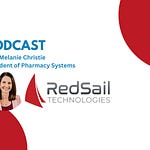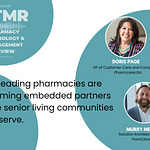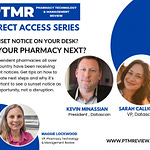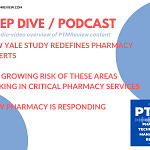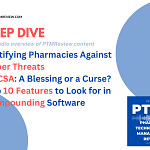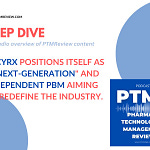In this interview, Pharmacy Technology & Management Review’s Will Lockwood talks with Anwar Kazmi, President of DAA Enterprises, and Karen Davis, CPhT, a seasoned pharmacy technician, instructor, and textbook author, and owner of SEPhT, a pharmacy technician educational company. Davis is also a pharmacy solutions consultant for KbPort, a software and hardware development company focused on improving educational outcomes.
What You Can Read About In This Interview
Revolutionizing Pharmacy Technician Training
Cloud-Based Training: A Game Changer for Pharmacy Techs
Essential Skills for Pharmacy Technician Certification
Mastering Insurance Claim Adjudication in Pharmacy Technician Training
Advanced Modules for Comprehensive Pharmacy Technician Training
We’ll take a look at how DAA Enterprises is revolutionizing the training landscape for certified pharmacy technicians (CPhT) programs through DAA’s Visual SuperScript Cloud Edition pharmacy management software, designed to provide aspiring pharmacy technicians with an unparalleled, realistic training environment and practical experience.
Find out how the system bridges the gap between theoretical knowledge and practical application, offering students individual "pharmacies" to manage with robust simulation of complex workflows that provide crucial experience with tasks like insurance claim adjudication and medication synchronization — all vital for success in today's demanding pharmacy settings and for meeting rigorous certification standards.
Revolutionizing Pharmacy Technician Training
PTMReview: We're going to be talking with Anwar Kazmi and Karen Davis about DAA Enterprise's efforts to provide training solutions for certified pharmacy technician programs. Anwar, do you want to start off by introducing yourself?
Anwar Kazmi: Sure. Thank you, Will. I am the president of DAA Enterprises. We have been in the business of pharmacy management software systems for a little over 40 years now. We were asked by the president-elect of what was then called the National Association of Retail Drug to develop a computerized system for their members. And it was referred to or described as a “smart typewriter” in those days. Of course, pharmacy management software has come a long way since then. And DAA has been part of that evolution at every step of the way. In the year, around 2005, 2006, we partnered with one of the nation's leading publishers of educational materials to adapt our pharmacy software to the educational environment for pharmacy technicians.
And our most recent offering in this area, both in the commercial as well as in the educational environment, is a cloud-based system, which is very sophisticated and has many benefits for pharmacists, for instructors and for students. And we can go into the details of that when you think it's appropriate, Will.
PTMReview: Okay. Wonderful. Thank you for that background. And before we jump into talking about that cloud-based system and how it supports training pharmacy technicians, we also have Karen Davis with us today. And Karen, would you just introduce yourself?
Karen Davis: Sure. I've been working with DAA for a long time, about 17 years I think at this point. I am a pharmacy technician. practicing since 1983 and I have been certified since 1995, which was the first test. I write textbooks for several publishers. I have served as a guest surveyor for ASHP for about five years.
I'm an instructor as well, and I own my own business now that sells TeachMEDS and aligns with different companies to provide software for training. I know this is an area that is needed in technician training programs because they need real world experience.
This program allows them to basically use and demonstrate techniques before they get to be out in the workforce that is actually dealing with patients. Been working with DAA for a long time. The software has been a long time coming and I think it's great for the programs.
Cloud-Based Training: A Game Changer for Pharmacy Techs
PTMReview: Okay. Thank you so much for that. So we'll jump into talking about this pharmacy software that DAA offers and how it's used in a pharmacy technician training program. And in particular how it can represent the workflow of a pharmacy in a realistic way that allows the students to develop practical skills.
"This program allows them to basically use and demonstrate techniques before they get to be out in the workforce that is actually dealing with patients."
So Anwar, if we can, let's start with you and let's talk a little bit about that. The way that the software, your cloud-based software, offers the ability to create a real world pharmacy workflow in the training environment with all the various queues and dashboards. And tell me how you've designed this to create the optimal learning experience.
Kazmi: Yes. It would be a pleasure to do that. First of all let me also just add here that we are very fortunate to have Karen Davis as a partner. Her knowledge, her experience in this business. And she is just a joy to work with and we feel blessed to have her as a partner.
Now coming back to your question. Let me first mention that the system is designed in such a way that for each student it's like they're operating their own pharmacy. The whole database is replicated as soon as a student's record is created, a student is added to the institution.
All the different files and patients, doctors, drugs, and so on and so forth are replicated for that student and it's as if they are operating their own full fledged pharmacy. I think that's a unique feature of our system and it's very different from other systems. Even for the educational environment where it may be like a demo version of a company's software and it's installed on the school network, for example, with maybe one or two terminals.
"For each student, it's like they're operating their own pharmacy. The whole database is replicated... it's as if they are operating their own full-fledged pharmacy."
Only one or two students can work with it at a time. And then a big disadvantage is that if there are some exercises that are either prescribed by the instructor, or that are in the accompanying workbook, as soon as one student performs that exercise, it preempts others from being able to do that. The others just basically stand there and watch. So I think this one is completely different in its approach. Each student has their own independent pharmacy. They can add patients, doctors, drugs, fill prescriptions and not have any impact on their fellow students.
So I think that's something which is unique. The other advantage, from having this cloud based architecture, is the fact that the students can use it or can access it from anywhere at any time. All they need is some sort of a device capable of running a browser.
It could be a laptop. It could be a PC. It could even be a tablet. Just a device that is capable of running a browser, that's all that they need. And they can access the system from anywhere, teachers as well as students. And so that's also a major advantage of this.
Another one, which I should mention here, is something that saves the IT people of that institution from a big headache. They don't have to give access to anybody to their computer network, because the system is not installed on their network.
The students do not access anything on the school’s computer network. And so that's a big relief to the administrators, as well as the IT personnel. So these are some of the advantages. Now, as I said, once the student is operating like their own pharmacy. They can go through all the tasks that have to be performed in a real pharmacy.
We also have what we call a mock service for adjudicating claims. We obviously don't actually send these claims to a private third party, but these claims, whatever claim they submit, are intercepted by our software. Based on the adequacy of the data submitted, the students get either a “paid” response, or a “rejected” response. Then they have the opportunity to correct things and resubmit the claim. This gives the student a good feel for what happens in the real world.
And we can talk about that in greater detail as well.
PTMReview: Okay, wonderful. And so the real key difference I'm hearing is that clearly in a real world pharmacy environment you do not want more than one person doing the same thing at the same time or working on the same record, changing records in a serial manner or whatever.
PTMReview: But in an educational environment, it's really important, like you said, for each student to essentially be able to run and manage his or her own pharmacy. And you've been able to set the system, your system, so that it is offering that capability. And, but at the same time, this is the same pharmacy management software that is available for a live pharmacy environment.
Kazmi: Absolutely. Yes, exactly. And this is as close as one can get to an experience of working in a real life pharmacy.
PTMReview: Got it. But it recognizes those student specific needs and some other needs of an educational environment.
Essential Skills for Pharmacy Technician Certification
Karen, why don't we if you could talk a little bit about some of the essential skills that are taught by using this software. And I think Anwar touched on a few of them, but some of the things that are required by the Pharmacy Technician Certification Board, PTCB, and ASHP standards and some of the things that that students need to learn in order to be able to achieve the certification that's the end goal of these programs.
What are some of those essential skills?
Davis: Sure. I would like to just add a couple of things to what Anwar said. I think that's important to add, and it flows into this question, but the optimal learning experience when you're talking about PTCB and ASHP. It's really twofold , but one is that when we're talking about the students having their individual dashboards or individual pharmacies, the student needs to have real life feedback and they need to be able to work at their own pace. A lot of programs are hybrid and that's fine with both of the accrediting bodies, but they also need to be able to work at their level of understanding. I'll give you a good example. I have a student that's in a current class that is already a pharmacy technician. Obviously she's using a community program at this point. So she's not learning the basics of how to put in a prescription, but in her class, she has several people that don't even understand what the word DUR says.
So I'm able to go in and change her permissions and actually assign her tasks that are specific to what she needs to be learning. And it may be a little ahead of some of the others, but I can do that and it doesn't affect the others' work. And so that's a really optimal learning experience for that student to learn at the level they're already at when they enter that program.
And then the other piece of that is for the instructor, because the instructors can simulate prescriptions and create scenarios in our system, which is not available anywhere else. It's something that we wanted and have been looking at adding for a while. But PTCB and ASHP both want a working environment and it needs to simulate what's real life.
"You put them in front of a computer, you say, here's a reject. What would you do with this? Here's a DUR. What would you do with this?"
They need to have a way to do that where it's safe and there's not a real inherent danger to a patient. So prior to getting to an employment situation, they can go through and learn all these tasks that are required in the community process, and then they get real feedback.
The students get a scenario given to them by the instructor, and then they get that feedback in their system that nobody else sees. And so to set that up is part of what ASHP wants. They want a real simulation. They want to show them. So again, if you look at the standards for ASHP and PTCB, between the two of them, it's about 60% that they need to cover between error prevention strategies and order entering and processing.
That's a huge piece of a program. They actually use this commercial version to be able to demonstrate those tactics. And you can talk to a student all day about, here's a scenario, here's what would happen, what would you do?
But you put them in front of a computer, you say, here's a reject. What would you do with this? Here's a DUR. What would you do with this? Patient calls in with a prescription for a controlled substance. How do you handle that?
This system allows them to do those functions in that system prior to getting to somewhere that they are going to be forced to do in front of a patient or not be able to do it at all because they won't be able to get on the computer. So the standards really matter.
PTMReview: It's able to take it from that textbook, that sort of theoretical discussion to a real practical exercise of we talked about this, perhaps, and now show us how you do this within a real pharmacy management system, but one that's very specifically controlled for the task at hand for that student who needs to demonstrate that skill.
Davis: Exactly.
PTMReview: Okay. That does sound very critical. Both as a learning tool for the students, and also as a way to really be able to meet these standards and teach so that they are able to successfully pass these certification exams.
Mastering Pharmacy Claims Adjudication in Training
Alright. Wonderful. Anwar, another area that I wanted to talk about, and you jumped into it a little bit and said we could get back to it, was this whole simulation of insurance claims. That's obviously a very complex area in pharmacy with a lot of variation depending on the plans and depending on the patients.
Dive a little bit more into that for us. Talk about how you are helping students learn how to manage responses and rejection messages- and Karen, you mentioned DUR codes things like this- learn about these tasks and gain real practical experience with them in a controlled environment.
Can you tell us a little bit about that, Anwar? And if you want to jump in, Karen, go ahead and jump in, too.
Kazmi: Okay. I appreciate that. Yes, I, as I said earlier, we have it's, the system is actually a full, fully fledged pharmacy management system with certain restrictions.
For example, we don't actually submit a claim to a third party. We have what we call a mock service that simulates that. But other than that the parameters, if I can use that term, for submitting claims are defined by what we refer to as an insurance table.
This is something standard in pharmacy management software. The parameters define what are the copays for brand name and generic drugs; which drugs are covered and which ones are not; and so on and so forth. Students work with exactly those same insurance plan tables that would be used in a regular pharmacy.
Now, as you said Will, that adjudication of claims can be something very complex. So we deal with all kinds of cases. Some of them could be relatively straightforward. For example, you submit a claim and you get a message: refill too soon. It could be because you filled that prescription only a week ago and it was for 30 days.
The system will put that prescription in a refill queue, and when the time comes for refilling, the system will bring it up and remind you about submitting that claim.
Similarly you can get a message: NDC not covered. The student could then select a different NDC, re-submit the claim and get it paid.
Now, there could also be more complex situations, especially those dealing with DUR, drug utilization review. You could get a pregnancy alert, for example, when filling a prescription for a woman who happens to be pregnant.
And you could have a drug over utilization alert, or an under utilization alert, a drug disease contraindications alert, or a drug-drug interaction alert.
So all of these kinds of alerts may come up during claim submission. In such situations, our system will give the trainee, the student pharmacy technician, the opportunity to address this situation. They may simply add that prescription to the queue of prescriptions that need to be reviewed by the pharmacist. Or, having taken appropriate actions under the supervision of the pharmacist, such as consulting the prescriber, resubmitting the claim with appropriate DUR Codes indicating the actions taken and the outcome of those actions.
So these are the kind of things that should give the pharmacy technician a feel for what they're going to encounter in real life situations.
PTMReview: They will have had practical experience working through these within a pharmacy management system, as opposed to just, like we said earlier, running through scenarios. And not having that practical experience of actually executing the tasks within the system. Karen, any anything you want to add to that?
Davis: Yeah. When they get to externship, and I understand this, but most of the time they're not allowed to get on the computer and do things like adjudication or look at these reject messages or understand what a reject message is and the proper way to handle that, because they can't get to real patient information because of HIPAA, obviously. But again, when you're talking about teaching these students and the didactic piece of it matching up to the laboratory, this gives you an opportunity to do that.
"The goal of this is to get these people employed. And so if you send them a student that has done these rejects, have had this experience...they're more employable."
So then you can say, here's all the terminology. Here's what we've discussed. Here's what's going to happen. Now let's go in and put it in practice. And they can go in and, again, the teacher can simulate different scenarios to create those messages. They can put in a prescription that they know needs to have REMS [Risk Evaluation and Mitigation Strategy]. They can put a prescription that needs to have a prior approval, that they know is going to reject because of a DUR, so they can set that up. And when you're talking about teaching it in a CPhT program, that's what you need because ASHP requires a certain amount of lab work versus didactic.
And then, the externship piece, if they go to a place that doesn't let them have it in detail, you've covered that in your classwork. You've made sure that has been something that they understand. When they see it in real life, they've done it already.
PTMReview: And it's certainly going to make that externship all the more valuable when they have some practical experience, and they are going to have better questions, better observations, a better understanding of what they're seeing in that externship, even if they aren't, as is very reasonable, aren't allowed to actually do anything practical.
Davis: The goal of this is to get these people employed. And so if you send them a student that has done these rejects, have had this experience, and they go in and say, you can't fill that prescription. It's got a DUR. You're not going to have to take the time to explain what DUR means.
They're going to understand what that means and go, okay, that means it was rejected. Let's take this action. So again, they're more employable and the people that are hiring these people, they expect them to know that if they've come through a training program,
Anwar Kazmi: Just to further what Karen said I think a short while ago, she said that people may not be familiar with what DUR stands for.
I think another one of those frequently encountered acronyms is DAW, which means dispense as written.
Davis: Yes.
Kazmi: And again, many people may not be familiar with it, but one of the exercises might be: you submit a claim for a drug, which is quite expensive, and then you get a very low reimbursement for it. And then you realize, oh we didn't submit the proper DAW code, which is that the doctor has indicated that needs to be dispensed as written. And so they can resubmit that claim with the proper DAW code of 1 instead of a 0, and voila, you get much more reimbursement that the pharmacist can live with, instead of losing money. And so that's the kind of exercise that a student can go through and they will hopefully remember it, for a long time.
PTMReview: It's such a good point that both of you're making. These details, these very important details that oftentimes, because of the workload within pharmacies, there's so much that's abbreviated. And so you have to be up to speed on that. And this is a way to do that. And again, and I keep emphasizing this, not just have heard and written on a test DUR means this, but oh, I've actually had experience managing a claim that had a DUR issue or managing a claim that had a DAW issue.
Davis: The other thing I'll add to that is, today's pharmacy practice is a value-based practice. The reimbursements for prescriptions are based on adherence to the medication regimen.
All of that is pulling into externship sites that take our students and want them to be trained, but at the same time, they don't want to be teaching them the basics of something. They should have come through that program already knowing. Time is money, and certainly it is in pharmacy.
That is how it is. But you want that to be the focus of when they start their training at your facility, they should have those basics under their belt. They should have at least looked at a DUR, handled a reject, sent for a prior approval. Something that they've already done.
It's a common task that happens every day. And then they understand the processes of what that pharmacy's going to teach them in their methods, their system, their workflow process. That's what they have to teach them, not the basics of being a pharmacy technician.
Advanced Modules for Comprehensive Pharmacy Technician Training
PTMReview: Absolutely. Okay. I've got one more topic that I'd like to touch on today. And I can take that as an opportunity to say that this is the first in a series of several conversations we're going to have with you all. And so we can look forward to getting into some other topics in the future.
But given the fact that this is a live deployed system that these students are training in and that the faculty have this detailed control over, Karen, are there any more specific modules within the pharmacy workflow that that you wanted to highlight as really critical for training within a C.Ph.T program?
Davis: Yeah, so the workbook that's going to come with this will have, obviously, exercises that go through the basics of using the program, inventory control reports and that. There's a couple of other things. One is the system has the capability of doing med sync, which is a program to get the patient to come in one time a month to get their medicines.
We do have texting capability, so they can actually simulate a text to a patient that says, "Hey, come in, you've requested a refill, but you've got three medicines. You haven't had the other two in two months." They can do a scenario and in the lab book, there will be a lesson for that to teach them how that med sync program works.
And again, as part of adherence, with the focus on pharmacy practice today, that's something that technicians are very integral in. They do the reporting, they check the profiles, they make sure they're accurate. .
Then the pharmacist obviously does a consult, so that's one of the modules that I think really shows off in this program. Able to go in and look at the profiles, put notes in, do auto refills, send text messages, interview patients.
The other one that I think is really neat is non-sterile compounding. We have capability in this system to put in either a specific compound, where you add in all the ingredients and prepare labels for non-sterile compounding.
The drug file is huge. There's a lot of medications there. Even if you wanted to make diaper rash ointment or something, all those pieces are there. That teaches the students how to go in and use the documentation that's required today for USP 795. And that will be in the workbook as well.
I think that's something that community pharmacies are doing more of, the med sync obviously, but they're doing more compounding. Sometimes it's a separate part of that independent pharmacy. And sometimes it's just another piece that they offer.
This system allows them to go in, they have to calculate the amounts of their bases and their medicines. And then they have to prepare a label. And then of course, then they would go through with the lab piece of preparing the compounds. But both of those things I think are really important and it's something that this system lends itself really well to doing for the students.
PTMReview: Okay. That's an impressive and robust list of modules and tasks that students can gain experience in with this system. So thank you for outlining all of that. That was extremely informative and, like I said, we'll look forward to having another conversation soon.
I want to thank you both for your time and for your expertise in talking about this important task of training future certified pharmacy technicians that are a backbone of pharmacy operations.
Davis: Thank you very much. Will, we appreciate it. It's a great program. We're doing demos for anybody who would like to look at it. Like I say, it's got a lot of features that are just a lot to put into words in a short time, but a lot of things in there for us to build on later.
Kazmi: Ditto here, appreciate this opportunity to share with students and teachers some of the capabilities of our system. We are really excited about this new system because it offers so many advantages compared to the systems that have been in use in the past. So we're really excited.
PTMReview: And, oh, and one final thing I'll ask you to highlight for us is, I know you're going to be out at a conference soon showing this software to pharmacy technician training programs and educators.
Can you just tell me a little bit about that and where that will be and what people can expect and maybe how people can find you there?
Davis: We will be at the Pharmacy Technician Educators Council Conference (PTEC) conference, July 10th through 12th in Columbus, Ohio
DAA will have a representative there with a computer set up so that you can look at the software. And also I'll be there with my TeachMEDS and information regarding KbPort institutional software and cabinets which is also something I sell.
We will definitely love to have people visit us at our booths.
PTMReview: Okay. All right. Wonderful. People can look forward to finding you there and learning more. Thank you again, and I'll look forward to speaking with you soon on this topic further. PTMR
Sponsored







